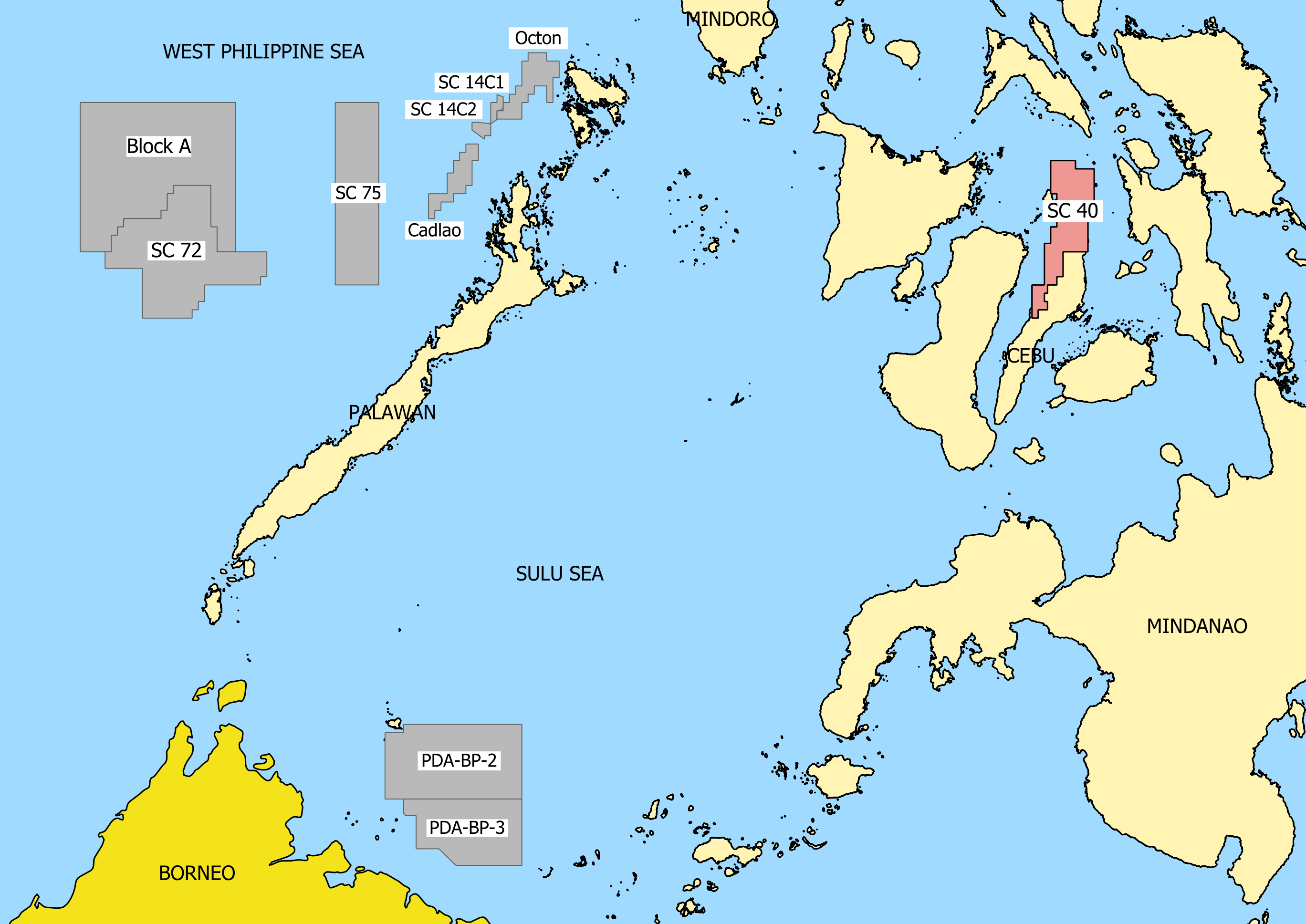SC 40 North Cebu

SC 40 North Cebu
Forum Exploration, Inc.: 100%
The North Cebu Block or SC 40 is located in the Visayan Basin in the central part of the Philippine Archipelago. The licence area covers the northern part of Cebu Island and the adjacent offshore areas in the Central Tañon Strait and Visayan Sea. The DOE considers the basin as among the most prospective in the country, next only to the producing Northwest Palawan Basin.
The block was originally awarded as Geophysical Survey and Exploration Contract (GSEC) No. 69 to a consortium led by Forum Pacific, Inc. (FPI). The concession was subsequently converted to a service contract, SC 40, on February 19, 1995. In November 1997, FPI transferred its interest in SC 40 (Cebu) to Forum Exploration, Inc (FEI), at that time a wholly-owned subsidiary of FPI. In April 2003, Forum Energy, through a subsidiary, acquired from FPI 66.67% of the issued shares of FEI.
The original term of the Exploration Period of the service contract was for seven years from 1995. In September 2003, FEI extended the contract a further three years, with DOE-approved work programme commitments for each year. On November 25, 2005, SC 40 entered the Production Period following the signing of the Joint Determination of Commerciality on Libertad Gas Field. This automatically extended its term for 25 years and deferred the company’s commitments for the last few years under the Exploration Period. In addition, a Libertad Production Area totaling 80 square kilometers was approved.
In 2013, PGS produced an Oil & Gas Competent Person's Report covering the whole block. Estimated in-place contingent resources is 14.1 million barrels of oil from the Maya and Toledo prospects, while prospective resources is 644.2 million barrels of oil from the other prospects and leads. In 2014, a block-wide Geological and Geophysical (G & G) studies were carried out to identify and prioritize highly prospective areas for future exploration.
Libertad Gas Field
The Libertad Gas Field is situated in Bogo City, north of Cebu City. The field was discovered in the late 1950s but was not developed. In 1993, a testing program was carried out on two wells and from 1994 to 1995, five additional wells were drilled in Libertad. One of these wells, L95-1, tested gas and was subsequently completed as a gas producer.
In 2004, Forum carried out a feasibility study to determine the most commercially viable option for the development of the field. The results of this work recommended a development plan using gas-to-electricity generators with a maximum capacity of 3.0 MW.
In 2009, a Gas Sale and Purchase agreement was signed with local company Desco Inc. to generate power on-site. Forum’s role was limited to supplier of natural gas, with Desco as the buyer. Desco, in turn, shall sell the generated electricity to the Cebu Electric Cooperative (Cebeco II) under a Power Supply Agreement. In 2011, construction works were completed and a 1MW GE Jenbacher engine was installed at the power plant facility. In February 2012, commercial gas production from the L95-1 well officially commenced with initial production rate at 240,000 cubic feet of gas per day. In August 2015, the well was shut-in due to a rapid decrease in formation pressure. The field was finally decommissioned in 2017 after producing a total of 208.9 million cubic feet of gas.
Forum conducted onshore gravity surveys in Toledo and Maya areas in 2009 and in the Bogo, San Remigio, Medellin, Tabogon, and Daanbantayan areas in 2012-2013. In early 2017, another gravity survey was conducted to investigate an apparent structure in San Remigio, which was observed from the results of the previous survey. Recent land gravity surveys were conducted in Daanbatayan, Medellin, and Bogo from 2019 to 2020 to further delineate the carbonate bodies detected in the said areas. Forum also reprocessed a number of onshore and offshore 2D lines in preparation to a block-wide re-evaluation of SC 40. The aim of the study is to generate prospects for drilling.
Maya Prospect
The Maya area is located on the northeastern tip of Cebu Island. It was first tested in the 1960s to 1970s by a number of companies, including Chinese Petroleum Corporation, which drilled an oil discovery, CMB-2, in 1972.
In 2003, Forum Exploration, Inc. drilled the three wells, Forum-1X (with its deepened section referred to as Forum-1XA), Forum-2X, and Forum-3X. These wells found sandstone layers that are thicker than any encountered in the older wells. The compelling gas shows (kicks and blow outs) associated with these sandstone intervals were attended by oil indicators. The wells Forum-2X and Forum-3X apparently did not bottom out the series of sandstone beds. There was an attempt to test Forum-2X but this was suspended due to mechanical problems. Any new well to be drilled in the area should implement a fluid and casing program that will address the high pore pressures and swelling of formation clays encountered in previous wells.
Dalingding Prospect
Dalingding Prospect is a seismically-defined feature interpreted as a reefal buildup associated with the milestone facies of the Upper Miocene-Pliocene Barili Formation. The Dalingding-1 well, drilled in 1996 by Cophil Exploration, was intended to test the structure. The well was drilled to a final depth of 1508 ft and encountered a 3-ft limestone at the bottom, from which flowed 900 barrels of brackish water per day with undetermined amounts of gas. The well was plugged and abandoned as a dry hole. Technical reviews indicated that Dalingding-1 did not reach the top of the Barili Limestone.
In 2009, Forum reprocessed several vintage lines in SC 40, including those located over the Dalingding structure. At the well location, the top of the Barili is at 0.51 sec and would require a drill depth of 1,740 ft to penetrate using a velocity value at Jibitnil-1 for the correlative overburden. Since Dalingding-1 had a total depth of 1,508 ft, it is believed that the Top Barili was not reached by the drill bit. A new well will be required to penetrate the Barili Limestone and secondary objectives below.
